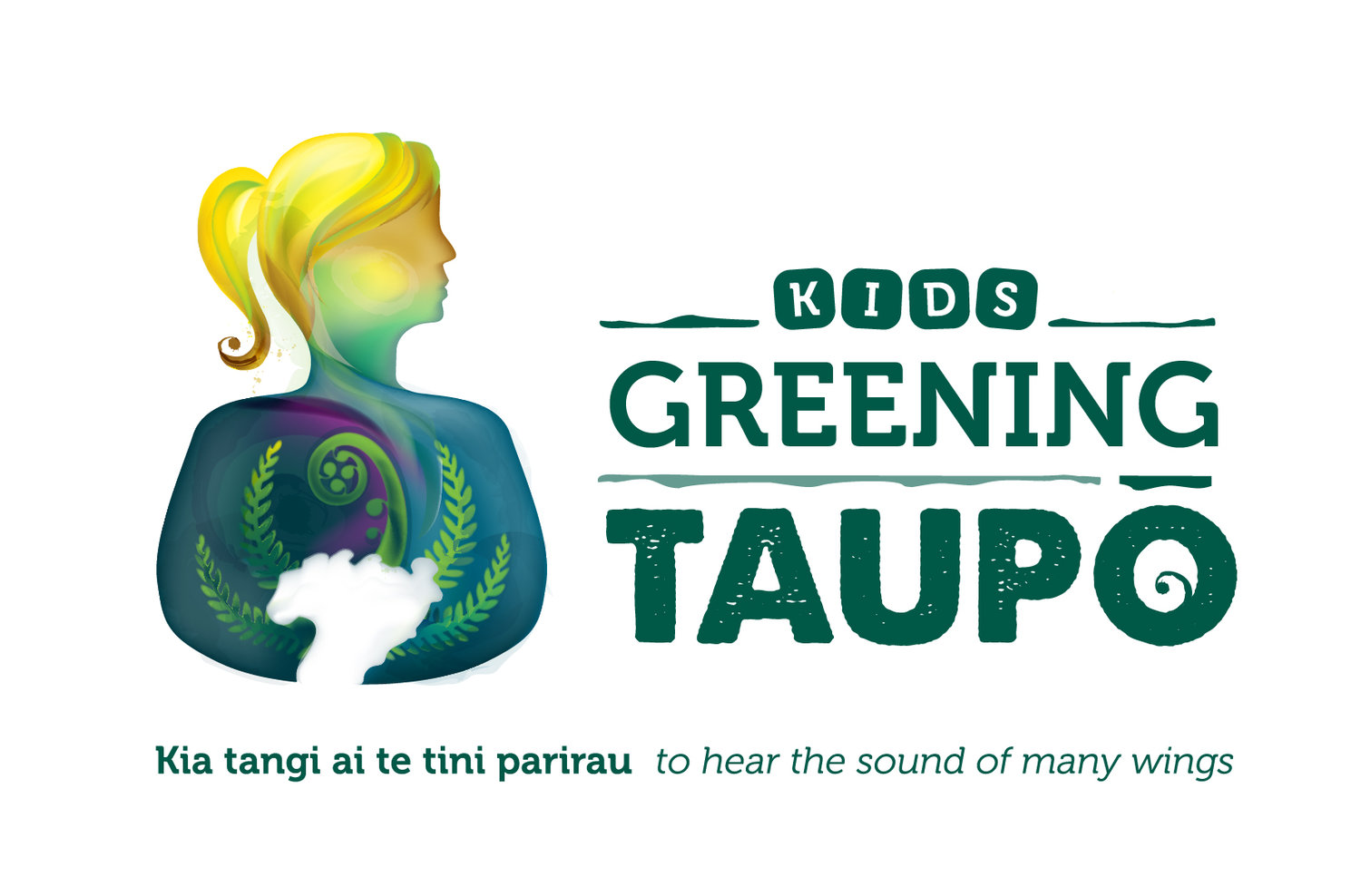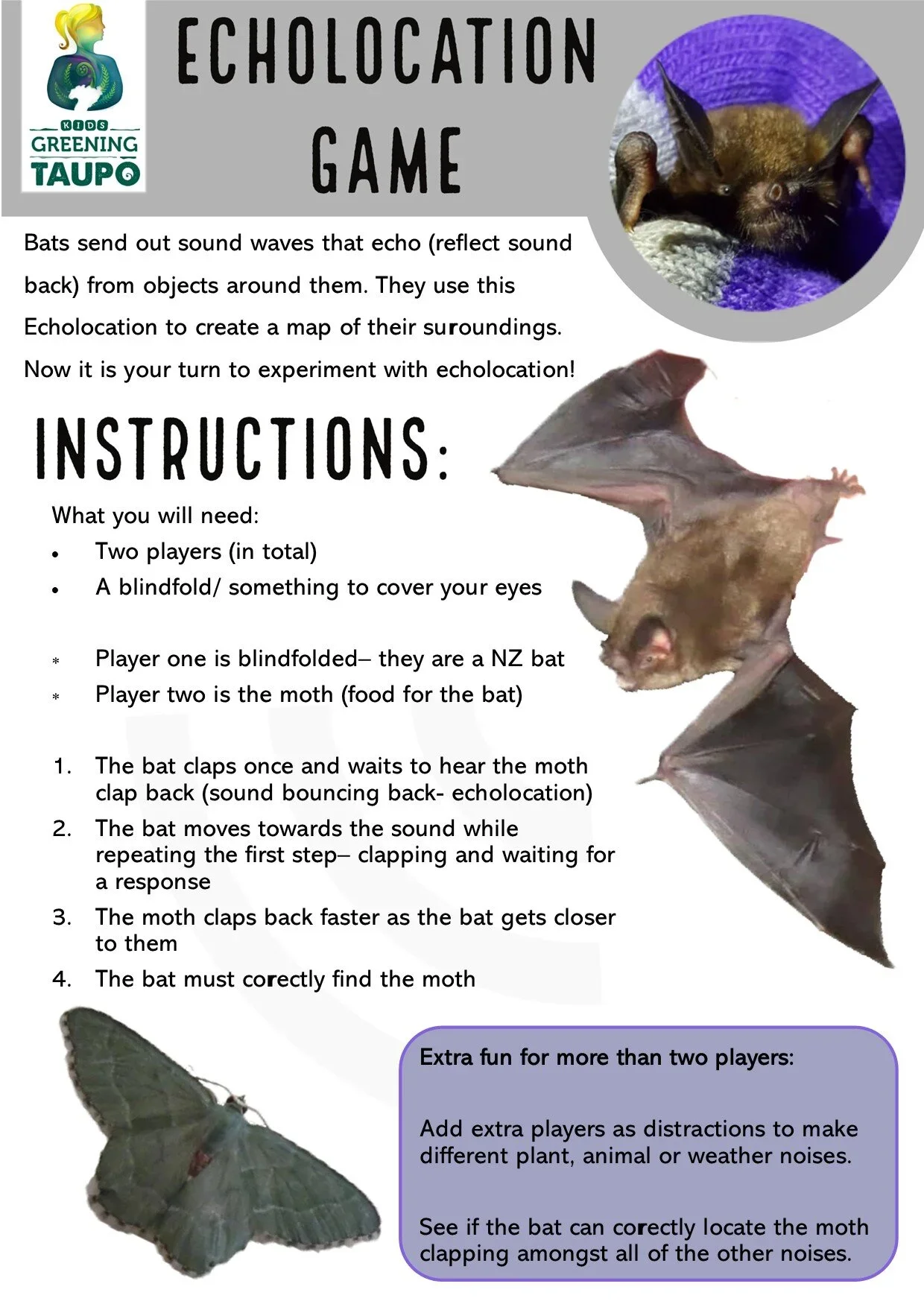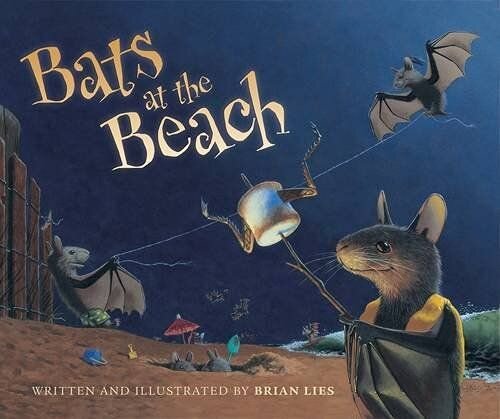Pekapeka/Native Bats of Aotearoa
Nau Mai! Welcome to the Kids Greening Taupo Online Nature Classroom!
This Online Nature Classroom is all about the pekapeka/native Bats of aotearoa
New Zealand has two living species of endemic bats (found only in NZ): the long-tailed bat, and the lesser short-tailed bat, both are threatened species. A third species; the greater short-tailed bat is thought to be extinct (no living individuals left).
Lesser short-tailed bats have big pointy ears, a short tail and strong legs. They are found in a few isolated locations in Aotearoa. Long-tailed bats are smaller than the lesser short-tailed bats. They have smaller ears and a long tail (enclosed in the wing membrane), and they are more widely distributed.
How small are these pekapeka? Imagine that your thumb is the body of the pekapeka. Use a ruler to show how big the wings would be- sometimes these can be up to 30cm in span (all the way across both wings). Perfect for navigating the ngāhere and flying up to 60km/h.
Bats are nocturnal, meaning they are more active at night. We will be learning about a special technique (echolocation) that bats use to create a map of their environment while navigating the forest at night in day two of this unit.
People often hear about the bats that suck blood and spread disease throughout the world, and believe that all bats are the same, but our native bats are different. Our native pekapeka don’t drink blood or spread disease. Instead, long-tailed bats feed on insects while flying through the ngāhere (forest), and lesser short-tailed bats find food both in the air and on the ground (this is rare in bats). Lesser short-tailed bats use their folded up wings with little claws on the ends as arms and crawl around on the forest floor (like rats), feeding on insects, pollen, nectar, seeds and fruit.
These bats are important seed disperses and pollinators in our native forests, without them some very unique species would go extinct. Lesser short-tailed bats have a special pollination relationship with a unique plant called the Te Pua o te Reinga (Dactylanthus or ‘wood rose’) . It is Aotearoa’s only fully parasitic (lives off other living things) flowering plant species.
Learn more about Te Pua o te Reinga here and how our team helped to monitor and pollinate it here.
Threats to our Pekapeka
Little is known about the lifespan of our native bats. The oldest known long-tailed bat was thought to be 24yrs old the last time it was captured. Monitoring programmes have been set up to track individuals throughout their lives to learn more about them and the threats they face. We do know that introduced mammalian predators such as rats, stoats, ferrets, and cats can predate pekapeka, which evolved without these animals. Lesser short-tailed bats are particularly vulnerable as they forage on the ground where introduced predators are often hunting. Bats also go into a state of torpor (kind of like hibernation) when it is cold, which means that they can’t move if predators find them in their roost. Pekapeka roost in big old hollow trees, so they are also affected by habitat loss, as many old areas of native forest have been cleared. Pet cats and feral cats can cause devastation if they find a bat roost.
Learn more about how to prevent your pet cat from harming wildlife here.
Have a go at this cool game from KCC
This awesome game is from KCC magazine. Go to the original source to download the pdf: https://kcc.org.nz/portfolio/battle-for-bats/
Are you ready to learn more about these incredible little native bats?
Check out this introduction video on bat monitoring:
Our ‘Fill your Kete’ section will provide you with some fun nature activities based around our topic. As this topic is pekapeka/bats of Aotearoa, our activities are based around animal groupings- mammals in particular, unique traits of our native pekapeka, echolocation, threats to our native bats, and ways to make bat friendly greenspaces/gardens/homes.
learn about mammals
Did you know bats are Aotearoa’s only native land mammals?
What are mammals? Learn what a mammal is in this video.
There are over 6000 species of mammals throughout the world. That’s right! While other countries have monkeys, bears, elephants, tigers and giraffes- we just have two tiny bats as native land mammals. We do however have native mammals living in the sea/ocean including species of dolphins, whales and seals.
Activity: What is a Mammal?
After watching the video, make a poster or slideshow, that explains what a mammal is. What makes mammals different to the other groups of animals?
Echolocation game
The saying ‘blind as a bat’ is far from correct. In fact, bats have incredible eyesight (20/20 vision), but they are active at night when vision isn’t very helpful (it is dark).
Bats instead use echolocation to navigate their surroundings. To do this, bats let out sound waves which humans cannot hear unless using a special bat detector. These sound waves echo (the sound reflects/comes back) off objects in the environment.
To test out your echo you could try yelling out in a valley- can you hear your voice come back to you?
Learn about echolocation in this VIDEO.
Our native bats of Aotearoa use their echolocation to map out their surroundings when flying amongst the trees, and finding food sources such as insects, fruit, and nectar. We have created an echolocation game for you to play. All you will need is a friend and something to cover your eyes (like a blindfold).
Build a Bat Box
In Aotearoa our native bats live in a variety of places including hollows of old trees, under loose bark, in holes on rock walls, in epiphytes (plants growing off other trees), and in caves. These bat homes are called ‘roosts’. Often many female bats and their young will live together in these roosts.
Unfortunately, a lot of bat habitat is old, dying trees and they are often felled (cut down) as they can become unsafe to humans. This leads to habitat loss for Aotearoa’s pekapeka species.
In areas where there is where there has been habitat loss or where few roosts remain, native plants can be planted to regenerate local green spaces. Another option is to provide wooden bat boxes (but this isn’t a long-term fix).
Check out this video of long tailed bats leaving a wooden bat box in Hamilton. How many bats can you count coming out of the box?
Native bats are present in some of our local forests, but little is known about their presence around residential/urban areas.
If bats are present it is important that our local green spaces are bat friendly. Trapping is extremely important to protect the native bats that we do have around, along with having suitable habitat and plenty of food. Learn more about the importance of bat friendly gardens here.
Learn how to make a bat box here.
Curiosity Questions
Bats in Aotearoa are rare and unique, but did you know that they live with another rare and unique creature that relies on them to survive? This fascinating creature is the New Zealand bat-fly. Both animals live together and help each other. Check out the cool batfly song in the video below!
Research and find out:
1. How do the lesser short-tailed bat and the bat-fly help each other?
2. What are the unique and special attributes that each of these creatures have?
After researching these two fascinating animals, share your findings with others. Make a video, or do a presentation to your class, friends or family. Teach others about them, why they are special, and how we can help protect them.
Take Action!
If you want to take this a step further, take action! Help protect our bats and other vulnerable species by:
setting some backyard traps, or even volunteering to monitor a local trapline
organise a bat box making session and get people in your community making bat boxes!
making a cat scrunchie or cat flick toy and taking action to keep your cat from hurting wildlife.
KI TE PANUI/ TO READ
This ki te Panui section is based on pekapeka/bats.
Head to the section below for the read aloud story, Peka and Koro: Friends of the Forest.
If you already have this book make sure you head outside to connect to nature whilst enjoying it!
After reading/listening to the book make sure to try the follow up activity- work out your bat wingspan.
In each Online Nature Classroom we will give book suggestions along with at least one video read aloud.
Our recommendation is Peka and Koro Friends of the Forest.
Watch the read along below (read by Sian from Kids Greening Taupō)-
Follow up activity:
work out your Wingspan and compare your bone structure
Aotearoa’s native bats have tiny bodies and large wings, perfect for squeezing many bats into a roost and flying through the forest. If you were a bat how big would your wings be?
NOTE: this is not a NZ bat resource. Measurements will be different for each species worldwide.
Let's dive deeper into bat wings and check out the bones involved in flight. When you compare bat wings to birds, and even humans, what do you discover?
Here is a cool comparison activity.
After reading about the similarities between human, bird and bat bone structures, use this colouring page to see if you can identify the different types of bones (tip- use a different colour for each different bone type).























